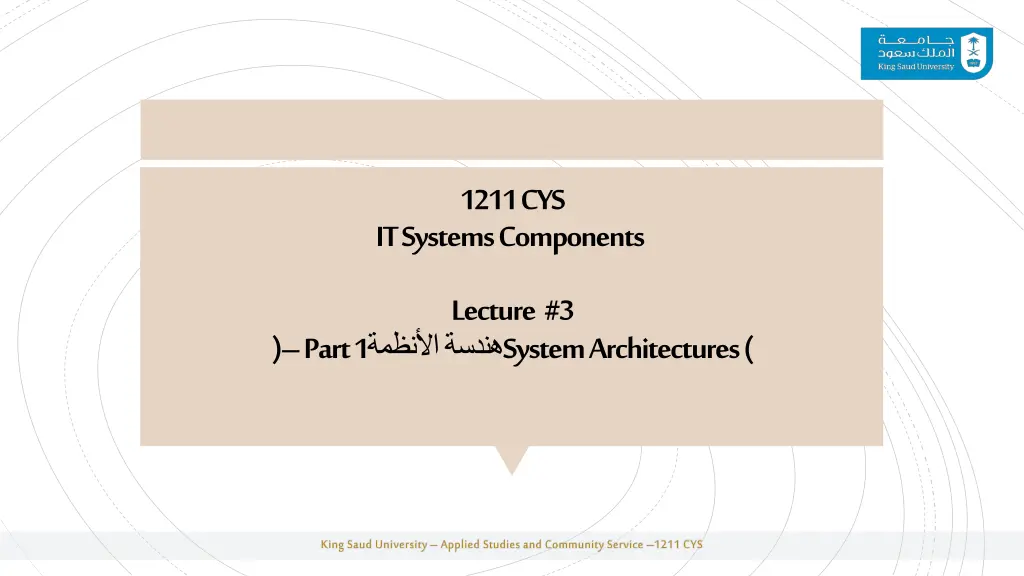
Understanding System Architectures and Cybersecurity Concepts
Explore the fundamental concepts of system architectures, cybersecurity, and the importance of security architecture. Learn about latency, bandwidth, and the elemental composition of system architecture. Dive into the phases of cybersecurity architecture and its benefits.
Download Presentation

Please find below an Image/Link to download the presentation.
The content on the website is provided AS IS for your information and personal use only. It may not be sold, licensed, or shared on other websites without obtaining consent from the author. If you encounter any issues during the download, it is possible that the publisher has removed the file from their server.
You are allowed to download the files provided on this website for personal or commercial use, subject to the condition that they are used lawfully. All files are the property of their respective owners.
The content on the website is provided AS IS for your information and personal use only. It may not be sold, licensed, or shared on other websites without obtaining consent from the author.
E N D
Presentation Transcript
1211 CYS IT Systems Components Lecture 3 # ) Part 1 System Architectures ( King Saud University Applied Studies and Community Service 1211 CYS
Topics: System Architectures Basic Concepts ( ) Elemental Composition of System Architecture ( ) What Is Cybersecurity Architecture ( ) What Is the Benefit of Security Architecture? ( ) Purpose of Cybersecurity Architecture ( ) Phases of Cybersecurity Architecture ( ) King Saud University Applied Studies and Community Service 1211 CYS
Identify system architecture elements. ) ( Describe Cybersecurity Architecture. Objectives Describe Phases of Cybersecurity Architecture. King Saud University Applied Studies and Community Service 1211 CYS
System Architectures The architecture of a system reflects how the system is used and how it interacts with other systems and the outside world. It describes the interconnection of all the system s components and the data link between them. The architecture of a system reflects the way it is thought about in terms of its structure, functions, and relationships. In architecture, the term system usually refers to the architecture of the software itself, rather than the physical structure of the buildings or machinery. The architecture of a system reflects the way it is used, and therefore changes as the system is used. For example, an airport may be designed using an architecture where the control tower and departures lounge are close together in the same building, while the control tower is further away in the same airport . . . . " " . . King Saud University Applied Studies and Community Service 1211 CYS
System Architectures Basic Concepts Therefore, the system is always described in terms of its parts and their operations. In the same way, data is always described in terms of the elements which compose it and the operations which make it useful to an end-user. Now that we know the system and its parts, let s dig into the data. . . . King Saud University Applied Studies and Community Service 1211 CYS
Basic Concepts of System Architecture Latency: In data transmission, latency refers to the time required in communication between two points. It is determined by the physical distance the data has to cover. . . : Bandwidth: In computing, bandwidth refers to the speed at which data is transferred for a fixed period and is usually measured in megabits per second (Mbps) or gigabits per second (Gbps). Inherently, the word bandwidth refers to the width of a communication band, which determines transfer speed. ( / .) . : ) / ( King Saud University Applied Studies and Community Service 1211 CYS
Throughput: The throughput of a system refers to how much information it can process in a given timeframe. Various aspects of computer, network, and organizational techniques are subject to this concept. . . : Horizontal and Vertical Scaling: To cope with growing demands, horizontal scaling entails adding additional servers or machines. The solution to problems like traffic overload is to add another server. . . :
Elemental Composition of System Architecture King Saud University Applied Studies and Community Service 1211 CYS
Elemental Composition of System Architecture Developing a system involves selecting the appropriate components to address the challenge at hand. Various cloud providers offer thousands of different features and stacks. Here we will discuss some of the fundamental elements of system architecture. . . . Virtual Machines:Virtual machines (VMs) are computer systems based on physical hardware but featuring their CPU, memory, network interface, and storage. A single piece of hardware, such as a server, can support multiple VMs, which are isolated from the rest of the system. : ( VMs) (CPU) . Load Balancer: In the context of distributed computing, a load balancer distributes traffic among multiple servers by acting as a reverse proxy. Increasing the number of servers horizontally makes it easier to scale. . . . : King Saud University Applied Studies and Community Service 1211 CYS
Database:During the operation of an application, data is stored and retrieved from a database. DBMSs, aka, databases because they manage physical data storage. DBMSs . . : Cache:The concept of caching in computing refers to storing small amounts of data, often transient, to make them more accessible than directly accessing them. Data caches can be used to repurpose previously procured or computed data effectively. . . :
What Is Cybersecurity Architecture A framework for describing how a computer network's standard operating procedures and security protocols should work together. The architecture of your cyber or computer system is also how different components are grouped, synchronized, and integrated. . . As part of a system's architecture, a cybersecurity framework is one of its components. A complete product or system is created and constructed around it. . . King Saud University Applied Studies and Community Service 1211 CYS
Security architecture is a framework for determining how your company's security controls and countermeasures fit into the broader system structure. Keeping your critical systems' quality attributes like confidentiality, integrity, and availability is the primary goal of these controls. . . In addition, it's the synergy of hardware and software understanding, together with programming expertise, research abilities, and policy formation .
What Is Cybersecurity Architecture Antivirus, firewalls, and intrusion detection systems are essential in defending your business from external threats. Your organization should develop a complete security architecture incorporating these many parts for your networks to maintain and optimize these security technologies and currently existing and working rules and processes. . . King Saud University Applied Studies and Community Service 1211 CYS
What Is the Benefit of Security Architecture? Fewer security breaches Modern technology necessitates an organization's use of a cybersecurity reference architecture framework to safeguard critical data. This dramatically minimizes the risk of an attacker successfully gaining access to an organization's network infrastructure. With security architecture, a firm may create a risk-free environment while adhering to the most current security standards and business requirements. . . . King Saud University Applied Studies and Community Service 1211 CYS
This is only one of the numerous advantages of this approach. Organizations may show their integrity and secrecy to prospective partners with the aid of security architecture. Confidentiality, Integrity, and Accessibility are the foundations of a solid security architecture. This will make it much easier for customers and partners to conduct business with and trust a company. . . . .
Purpose of Cybersecurity Architecture A cybersecurity architect is a perfect person to hire if you want to figure out where your system is vulnerable. Your sensitive data and critical applications will be adequately protected thanks to a cybersecurity architect's comprehensive examination of network topologies and cyber-attacks. . . King Saud University Applied Studies and Community Service 1211 CYS
Security architecture's primary objectives are: There must be a way to prevent any cyber-attacks from occurring. To avoid being detected and penetrated by cyber threats, attack surfaces should be kept tiny and hidden to make them difficult to detect. Ensure that all of your personal and sensitive data is securely encrypted and sent using end-to-end encryption protocols. Countermeasures like Moving-Target Defenses identify, mitigate, and counteract all cyberattacks (MTD). . . ( : . MTD).
The 3 Phases of Cybersecurity Architecture Security architects tailor their security approach to best fit their organization and sector, keeping in mind the risk calculations. Most plans have 3 common elements: . 3 : Phase 1 Develop Policies, Standards, and Best Practices Phase 2 Implementation of Phase 1 Phase 3 Monitoring of Phases 1 and 2 . . : : . : King Saud University Applied Studies and Community Service 1211 CYS
Discuss the System Architectures cybersecurity elements? King Saud University Applied Studies and Community Service 1211 CYS
End of Lecture King Saud University Applied Studies and Community Service 1211 CYS






















